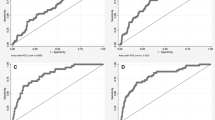Abstract
A naturalistic study of violent behavior in a sample of 100 boys residing within an inpatient psychiatric facility is reported. Over 1000 recorded incidents of interpersonal aggression were used to explore patterns of male violence in a contextually defined setting. Findings include a proportionately greater incidence of violence in younger boys. Staff members, particularly males, were more likely to be the victims of interpersonal violence, but peers and staff were equally likely to be the target of aggressive behavior in general. Observable provocation in the social context, the age of the child, and choice of victim (staff vs. peer) were found to be important predictors within a logistic regression model of violence. An estimate of the predictive utility of a logistic model for the occurrence of violence was found to be too low for clinical purposes. An application of a descriptive statistical method to collections of incidents for five highly aggressive boys yielded idiopathic models of violent behavior. Predictive accuracy estimates from these models suggest that multivariate description of behavioral data can be a clinically useful tool in understanding and possibly preventing violence within defined contexts such as residential psychiatric facilities.
Similar content being viewed by others
References
Achenbach, T. M., and Edelbrock, C. S. (1978). The classification of child psychopathology: a review and analysis of empirical efforts.Psychol. Bull. 85: 1275–1301.
American Psychiatric Association (1980).Diagnostic and Statistical Manual (3rd. ed.). Washington, D.C.: Author
Bem, D. J., and Allen, A. (1974). On predicting some of the people some of the time.Psychol. Rev. 81: 506–520.
Bem, D. J., and Funder, D. C. Predicting more of the people more of the time: assessing the personality of situations.Psychol. Rev. 85: 485–501, 1978.
Blurton-Jones, N. (1972).Ethological Studies of Child Behavior, Cambridge Univ. Press, London.
Craig, T. J. (1982). An epidemiologic study of problems associated with violence among psychiatric inpatients.Am. J. Psychiat. 139: 1262–1266.
Depp, F. C. (1976). Violent behavior patterns in psychiatric wards.Aggressive Behav. 2: 295–306.
Dietz, P., and Rada, R. T. (1982). Battery incidents and batterers in a maximum security hospital.Arch. Gen. Psychiat. 39: 31–34.
Gordon, R. (1983). How dangerous?APA Monitor 14: 4–5.
Grizzle, J. R., Starmer, C. F., and Koch, G. C. (1969). Analysis of categorical data by linear models.Biometrics 25: 489–504.
Hanley, C. (1979). Problems in the estimation of delinquency potential. In Toch, H. (ed.),The Psychology of Crime and Criminal Justice, Holt, Rinehart & Winston, New York.
Harrell, F. (1980). The LOGIST procedure. In Reinhardt, P. S. (ed.),The SAS Supplemental Library User's Guide, SAS Institute, Cary, NC, pp. 83–102.
Hartup, W. (1974). Aggression in childhood: Developmental perspectives.Am. Psychol. 5: 336–341.
Holland, T. R., Holt, N., and Beckett, G. E. (1982). Prediction of violent versus nonviolent recidivism from prior violent and nonviolent criminality.J. Abnorm. Child Psychol. 91: 178–182.
Kozol, H., Boucher, R., and Garofalo, R. (1972). The diagnosis and treatment of dangerousness.Crime Delinquency 18: 371–392.
Lewis, D. O., Shanok, S., Grant, M., and Ritvo, E. (1983). Homicidally aggressive young children: neuropsychiatric and experimental correlates.Am. J. Psychiat. 140: 148–153.
Manning, M., Heron, J., and Marshall, T. (1978). Styles of hostility and social interactions at nursery, at school and at home. In Hersov, L. A., and Shaffer, D. (eds.),Aggression and Antisocial Behavior in Childhood and Adolescence, Pergamon Press, Oxford, pp. 58–59.
Megargee, E. I. (1970). The prediction of violence with psychological tests. In Spielberger, C. (ed.),Current Topics in Clinical and Community Psychology, Academic Press, New York.
Megargee, E. I. (1976). The prediction of dangerous behavior.Criminal Justice Behav. 3: 3–21.
Megargee, E. I. (1981). Methodological problems in the prediction of violence. In Hays, J. R., Roberts, T. K., and Solway, K. S. (eds.),Violence and the Violent Individual, Spectrum, New York.
Monahan, J. (1981).Predicting Violent Behavior: An assessment of clinical techniques, Beverly Hills, CA: Sage.
Monahan, J. (1984). The prediction of violent behavior: Toward a second generation of theory and policy.Am. J. Psychiat. 141: 10–15.
Moyer, K. (1978).The Psychobiology of Aggression, Wiley Interscience, New York.
Mullen, J. M., and Dudley, H. K. (1981). Development of an actuarial model for predicting dangerousness in patients in maximum security mental hospitals. In Hays, J. R., Roberts, T. K., and Solway, K. S. (eds.),Violence and Violent Individuals, Spectrum, New York.
Mungas, D. (1983). An empirical analysis of specific syndromes of violent behavior.J. Nerv. Ment. Dis. 171: 354–361.
Offer, D., Marohn, R., and Ostrov, E. (1975). Violence among hospitalized delinquents.Arch. Gen. Psychiat. 32: 1180–1186.
Olweus, D. (1979). Stability of aggressive reaction patterns in males: a review.Psychol. Bull. 86: 852–875.
Pleffer, C. R., Plutchik, R., and Mizruchi, M. S. (1983). Predictors of assaultiveness in latency age children.Am. J. Psychiat. 140: 31–35.
Sall, J. P. (1982). The FUNCAT procedure, In Ray, A. A. (ed.),SAS User's Guide: Statistics, SAS Institute, Cary, NC, pp. 257–285.
Tardiff, K., and Sweillam, A. (1982). Assaultive behavior among chronic inpatients.Am. J. Psychiat. 139: 212–215.
Wenk, E., Robinson, J., and Smith, G. (1972). Can violence be predicted?Crime Delinquency 18: 393–402.
Whiting, B., and Pope-Edwards, C. (1973). A cross-cultural analysis of sex differences in the behavior of children aged 3 to 11.J. Soc. Psychol. 91: 171–188.
Author information
Authors and Affiliations
Additional information
This research was supported by a grant from the H. F. Guggenheim Foundation and a research fellowship from the National Institute of Mental Health, U.S. Public Health Service.
The author would like to acknowledge with appreciation the assistance of Sebastiano Santostefano during the completion of this project.
Received Ph.D. from Cornell University and completed postdoctoral training in clinical child psychology at McLean Hospital and Harvard University. His major research interests involve the etiology, description, and treatment of conduct disorders in children and adolescents.
Rights and permissions
About this article
Cite this article
Garrison, W.T. Predicting violent behavior in psychiatrically hospitalized boys. J Youth Adolescence 13, 225–238 (1984). https://doi.org/10.1007/BF02089061
Received:
Accepted:
Issue Date:
DOI: https://doi.org/10.1007/BF02089061




